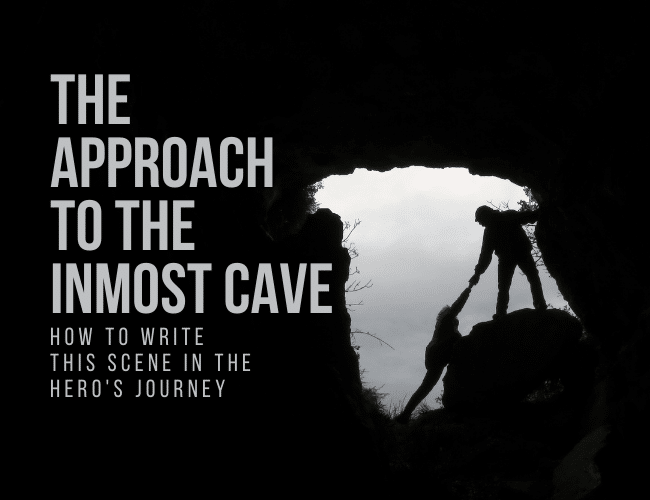Every great heroic story has that moment. It's the deep breath before the plunge. The quiet before the calamity. If you're writing a Hero's Journey story, you'll want to include this moment, too: the Approach and Ordeal. Or, the Approach to the Inmost Cave.

The Approach and Ordeal are essential moments you need to plan for as you draft your story. And to do it right, you're going to need to figure out three key elements:
- Your Story's Shadow
- The Stakes
- The Task to Complete
Let's explore each of these and talk about how they will take your story from “Meh” to “Amazing!”
Step 7: Approach to the Inmost Cave
This step can take many shapes depending on the story's genre and world. However, no matter where your story takes place, this definition applies:
The Approach is a moment of nervous contemplation before the massive Ordeal the hero must face. It is often a moment of final preparation, confession of secrets and fears, and abandonment by uncommitted companions, leaving the hero uncertain and isolated.
If you're outlining the Approach to the Inmost Cave scene for your story, you must keep the Ordeal, or the Climax, in mind. They are two halves of the whole, and one must keep both in mind when planning. However, in order to plan, you need to also understand the purpose of each (and how they work together).
For today, let's focus on the Approach to the Inmost Cave. And if you'd like to learn more about the Ordeal than what's discussed in this article, read about the Ordeal here.
How Did We Get Here?
As a quick refresher, the Hero's Journey is a storytelling theory by Joseph Campbell.
Refined by Christopher Vogler into a convenient twelve-step process, the Hero's Journey begins when the hero starts humbly (Ordinary World) and then experiences a Call to Adventure. The hero refuses that call, and finds themself encouraged and trained by a Mentor.
Next, through a combination of will and force, the hero steps over the boundary between safety and danger, the Threshold, and begins their journey in a world of Trials, Allies, and Enemies.
This usually brings you about two-thirds of the way through your story, up to the moment you've been waiting for: the Climax.
But before every Climax, a story needs an Approach to the Inmost Cave moment.
Step #7: Approach to the Inmost Cave
Before every climactic action scene is a deep breath. Sometimes portrayed as beginning with a montage or training scene, this scene is the moment when the Hero pauses, considers all that is at Stake in order to defeat the Shadow, and then soldiers onward.
This, in Christopher Vogler's words, is called the “Approach to the Inmost Cave.”
This moment is essential, and captures the universal human emotion of fear. All heroes experience some kind of fear, whether it's fear of death, failure, or the unknown. But before any great campaign against evil, there must be an Approach.
And with an Approach, comes a Hero's Ordeal (step eight in the Hero's Journey).
The Ordeal is the scene when your hero must complete a deadly task, putting everything that's at stake on the line, and ultimately confront the Shadow. This moment is the eighth step in the Hero's Journey, and comes directly after the Approach to the Inmost Cave.
Before this moment, though, you need a scene where the hero approaches the awaiting, climatic feat.
If you want to increase the tension and raise stakes in the Climax, you first need to write a scene that creates that calm before the storm. To do this, you need an Approach to the Inmost Cave scene that upholds three core elements.
3 Core Elements in the Approach to the Inmost Cave
In the Ordeal, the Hero confronts the Shadow and makes ultimate choices. This moment is thrilling, often action-packed, and offers the highest-stakes. However, the moment before this scene can't do the same thing. Instead there needs to be a brief, calm moment before plunging the Hero into battle.
Without this pause, the story won't elevate the suspense and tension. To get here, you're going to need to plan three storytelling elements:
- A Shadow character
- High stakes for success/failure
- A nearly-impossible task associated with the Shadow
With these elements in-hand, you'll be able to craft the next two steps of the Hero's Journey: The Approach (this article) and the Ordeal.
Let's start with the Shadow.
1. The Shadow: Get Your Villain Right
Joseph Campbell identified an archetypal character who appears in almost every heroic myth: The Shadow.
The Shadow is often called the villain. But what is more important is that they are a darker version of the hero.
Belloc, the greedy archeologist who steals from Indiana Jones in Raiders of the Lost Ark, says to him, “I am but a shadowy reflection of you.” For the Shadow to work, they need to be the “bad” version of what makes the Hero good.
Here are some elements that are often similar between Hero and Shadow:
- Physicality
- Background, family, and/or culture
- Goals
- Fears
However, other elements must be in opposition, otherwise there will be no reason to call your Hero “good” and the Shadow “evil.” Some include:
- Virtue
- Leadership style
- Faith
- Physical strengths
- Belief in “freedom” or some other positive societal value
- Opinions on physical violence
When the Hero and Shadow share several characteristics, this gives them reason to threaten one another and even consider teaming up.
In fact, you've probably seen the scene where the Villain invites the Hero to join them a thousand times:
- Darth Vader to Luke Skywalker in Star Wars
- Voldemort to Harry Potter in Harry Potter and the Sorcerer's Stone
- Magneto to Professor X (or other X-Men heroes) in the X-Men
They don't just share physical traits though; what must be common are deeply held beliefs about the central conflict.
Digging deeper into Star Wars, both Luke and Vader possess strongly held views on one essential element of the narrative: The Force.
Should the Force be used for “good,” or wisdom and defense, as Yoda teaches? Or should it be used for power, strength, and control, as The Emporer declares?
This life crisis is what gives Star Wars it's true power. It isn't just that Vader is Luke's father — it's that Luke's father is wedded to evil and all its virtues, and Luke fears what that means for his own life.
Without a shared trait like this, there'd be no reason for intense internal conflict. There would only be stark opposition, and the relationship would never find any depth.
And this is what readers love.
They may claim to love action or conflict, but what they really love is intense internal conflict within the hero. It's your job to create it.
So as you plan the latter sections of your heroic journey, make sure you get your Shadow right by designing shared traits with your Hero to keep things interesting.
2. The Stakes: Make Them Both Specific and General
When the time comes for the Hero to face the Shadow late in the journey, the stakes need to be higher than ever.
This has to be true specifically, for the hero themself, and it has to be true generally, for the world at large and the cast of characters you've put around the Hero.
No heroic journey is about the Hero alone, as every hero symbolizes a greater societal value: Hope. Freedom. Faith.
Yet the Hero must also have plenty to lose as well. That's why it's your job to place difficult hurdles before them, especially during this climactic event in the story.
Take the example of the Harry Potter books.
From a point of view perspective, the books are incredibly intimate, taking the reader inside Harry's tortured mind and lonely soul. Yet his epic adventures have worldwide consequences as he must confront the rising evil of the Dark Lord Voldemort.
If Voldemort wins, the bigotry of “pure blood” magic will win and wreak havoc on both the magical world and the realm of unsuspecting Muggles. Harry's character arc isn't just about him dealing with a big baddie; it's about saving two entire worlds from Lord Voldemort and his minions.
This is what heroes do: They go in place of the people and face a most ultimate form of death. They put their own skin on the line, but their actions have universal impact.
That's what makes them so beloved when they win, and so worshiped when they suffer and die.
As you plan this climactic moment when Hero and Shadow finally clash, make sure the stakes — both local to the hero and general to the world — are at their peak intensity.
3. The Task: Challenging and Unidirectional
Whatever the Hero must do to pursue their ultimate goal, there must be a massive task to accomplish.
Examples include:
- Storming a castle
- Surviving a death match
- Escaping from a monster
- Winning a fight
- Delivering a great audition
- Interview
- So on
These are the kinds of tasks we write poetry and songs about. These are the kinds of events that Lego builds toys about (except the audition/interview, of course).
There are two aspects of your confrontational task that must be incorporated into the design in order for them to be successful: Challenge and Direction.
First, the Task must be incredibly challenging.
It must be so challenging that your hero could not have succeeded in the first fifty percent of the book, and there's doubt whether or not they can succeed even now. It must be so challenging that the hero, or their companions, suffer to achieve it.
In this instance, consider The Hunger Games. One could argue that the games themselves represent the entire “Ordeal” stage of Katniss's hero's journey. It's not a common story structure, but it works in the world author Suzanne Collins is creating.
In the games, Katniss faces a monumental challenge: Defeat twenty-three other tributes, some from bloodthirsty Districts determined to capture victory. One of those tributes, of course, is her professed lover, Peta Malark. No easy task!
Note that the framing of the story shows Katniss approach the inmost cave, or the games, as she waits in the preparation room before rising into the arena. She and Peta eventually take revenge in a literal cave during the most critical moment when they are both injured and badly need medicine.
Not all stories prolong the Ordeal like Collins does. Others are brief but intense events, like an action or chase scene.
As an example of storming the castle, a common task in all sorts of stories from Game of Thrones to James Bond, the Shadow will lurk in a fortress with the object of desire (maybe a princess, a throne, a weapon, etc). In order to win the day (and prevent the awful Stakes from befalling humanity), the hero must infiltrate the castle, obtain the object of desire, and escape.
If you want this scene to be convincing, you can't have your hero sneak (or fight) in, grab the goods, and flee unscathed—at least not in this part of the Hero's Journey. You can get away with it as an opening bit (like in a Bond movie), but NOT as the climactic battle.
The Task must be overwhelmingly expensive in sweat and blood. The Shadow and their evil cannot be overcome with ease. Otherwise you'll lose your reader's catharsis and compassion.
Second, the Task must be unidirectional.
In other words, there can be no turning back. The consequences for even starting must be immediate. Everything must change. This is the turning point in your story.
So what needs to change?
Usually these elements must transform the hero and their world:
- The Hero no longer doubts the mission and will pursue it to the end
- The Shadow no longer exhibits patience or mercy and will do anything to destroy the Hero
- The world reacts to the Hero's choices: Evil creatures begin to actively hunt the Hero, good creatures actively protect the Hero
- The object of desire is moved, destroyed, or transformed somehow
Consider yet another example:
Pixar's Toy Story. Woody and Buzz's major challenge is to escape the hellscape that is Sid's bedroom. They do so, but emerge to a changed world.
Their Ordinary World, Andy's bedroom, is no longer where it used to be. It is in a moving truck, rolling away from them with great speed. They have emerged from their trial only to find that all is not well anymore, and the story continues from there.
Consider, finally, this last note. After the climactic scene between Hero and Shadow, the object of desire is often transformed in a way that alters the rest of the action. It all depends on what the particular MacGuffin is.
Often it is revealed that the desired object wasn't anything special at all, forcing the hero to reconsider their goals and priorities.
Often a key character is killed during the Ordeal, heightening the stakes and lessening the desireability of the goal itself. These crises are what make hero's journeys powerful, and don't be afraid to throw your hero to the wolves in the final act of your tale.
No matter what object of desire your Hero is pursuing, the climactic moment must change everything. There is no turning back. The choice must be unidirectional.
Bring it All Together
These three elements will help you plan steps seven and eight of the Hero's Journey. Let's bring them together to form a powerful one-two punch in the climax of your story.
Remember that your Shadow must represent all the evil and selfishness that your Hero fears. That Shadow must have the potential to ruin everything the Hero holds dear. And the Task set before the Hero must be monumental and seemingly impossible to achieve.
These elements, when properly designed and blended, will yield an incredible climax that your reader will love.
What are your favorite Hero's Journey Approach and Ordeal scenes from books and movies you love? Can you find these elements in them? Let us know in the comments.
PRACTICE
Take fifteen minutes to freewrite a scene where a hero contemplates facing an ordeal ahead. Don't worry about the specifics; instead, lean into the emotional challenge of facing the coming challenges. Here are some to inspire you as dream up a scenario:
- Your Hero's “Shadow” character: What traits might your Hero and the Shadow have in common? What separates them and makes them enemies?
- The Stakes involved: What could your Hero have to risk in order to defeat the Shadow and any other threat to the world?
- The Task: What incredibly challenging feat might the Hero have to accomplish in order to successfully confront the Shadow?
Post your writing in the Practice box, then find another writer's plan and leave a helpful comment on it!







0 Comments